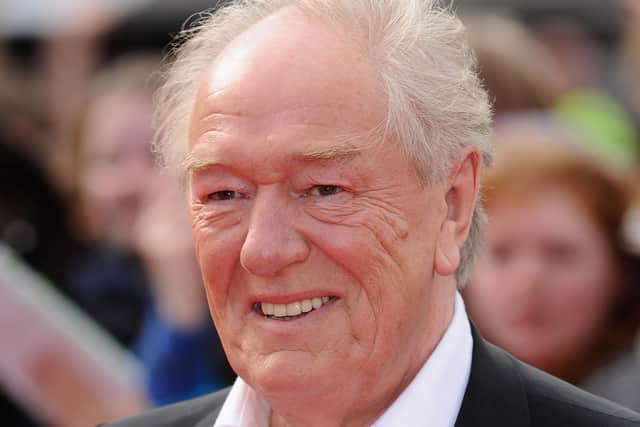Scotsman Obituaries: Michael Gambon, acclaimed theatre actor who found worldwide fame in the Harry Potter films
It was as Professor Dumbledore in the Harry Potter films that Michael Gambon belatedly achieved worldwide fame in his sixties, though he had made an impact in the UK in the 1980s in the television mini-series The Singing Detective, playing a hospitalised writer living in a fantasy noir world.
Gambon actually had a starring role on TV almost 20 years earlier in the BBC’s Scottish historical drama series The Borderers, alongside the Scottish actors Iain Cuthbertson and Edith MacArthur.
Advertisement
Hide AdAdvertisement
Hide AdHowever, it was on the London stage that Gambon achieved his greatest critical success. He played several of the great Shakespearean roles, but was perhaps more readily associated with contemporary playwrights and plays.


He was nominated for 13 Olivier awards, winning three for his performances in Alan Ayckbourn’s comedy A Chorus of Disapproval, Arthur Miller’s A View from the Bridge and Man of the Moment, another Ayckbourn play.
Gambon never seemed to take himself too seriously. He was not classically trained and dismissed acting lessons as “a load of bollocks”. He had the nerve to audition for Laurence Olivier at the National Theatre with a speech from Richard III, which was a bit like trying to impress Frank Sinatra with your own interpretation of My Way. Anyway it worked and he got the job.
Famed for his mellifluous tones, he was equally adept at tragedy and comedy and pretty much everything in between, nicely illustrated by the occasion that he took a friend up in a plane to demonstrate his skills as a pilot, sent his companion into a panic when he appeared to have a heart attack and then revealed it was actually just a little jest. Gambon was a great practical joker.
He was born Michael John Gambon into a working-class family in Dublin in 1940. His father worked in engineering and his mother was a seamstress. They moved to London just after the Second World War.
Gambon left school at 15 and took an apprenticeship as a toolmaker with the engine-makers Vickers-Armstrongs. His practical skills led him into theatre as a set builder before he decided to try his hand at acting, initially in amateur productions. He wrote to the famous Gate Theatre in his home town of Dublin with a largely imaginary resume and made his professional debut there in 1962 in the tiny role of the Second Gentleman in Othello.
Back in London he spent four years with the National Theatre in the mid-1960s, working his way up through roles of increasing significance, though provincial theatre was to offer him bigger roles sooner and he played the title role in Othello at Birmingham Rep when he was just 27.
The Borderers was set in the Scottish Borders at the time of Mary Queen of Scots, a period of huge political and religious upheaval, with the Borders themselves the scene of feuds, raids and battles. The Guardian described it as “a kind of north-eastern western”.
Advertisement
Hide AdAdvertisement
Hide AdIt ran for two series in the late 1960s. Several episodes survive and Episode One, Vengeance, is on YouTube, with Gambon’s bearded character Gavin Ker declaring his intention to go to France to expand his education and possibly find a more peaceful life.
A role in another television series, The Challengers, in the early 1970s led to a meeting with Eric Thompson, who worked on the series as an actor, but was about to direct Ayckbourn’s trilogy The Norman Conquests and was sufficiently impressed with Gambon to offer him a major role. He was part of the original cast that included Felicity Kendal, Penelope Keith and Tom Courtenay, in the title role played by Tom Conti in the television adaptation. The three plays depict six characters over the course of a weekend.
Gambon’s tour-de-force performance in Bertolt Brecht’s sprawling Life of Galileo in 1980 prompted fellow actor Ralph Richardson to refer to him as The Great Gambon.
He reached a wider audience and won the first of four Bafta awards in Dennis Potter’s musical fantasy-drama The Singing Detective, playing Philip E Marlow, a detective fiction writer, who is hospitalised with psoriatic arthropathy, a serious skin and joint disease, from which Potter also suffered.
Hidden behind bandages, Gambon had to do much of the acting with his eyes, though his character does escape into a Chandleresque fantasy world.
Gambon’s big-screen credits include Peter Greenaway’s The Cook, The Thief, His Wife and Her Lover; Gosford Park; Brideshead Revisited; The King’s Speech, as King George V; the starry, but rather misjudged reboot of Dad’s Army, as Private Godfrey; and of course, the Harry Potter series.
Richard Harris portrayed the Hogwarts headmaster Professor Albus Dumbledore in the first two Harry Potter films. Gambon took over when Harris died in 2002 and played him in the remaining six instalments. Gambon was knighted in 1998.
Gambon loved mechanics and collected antique clocks and guns. As well as being a qualified pilot, he was passionate about cars and drove so fiercely on the Top Gear test track that he took the last corner on two wheels and it was subsequently referred to as Gambon Corner.
Advertisement
Hide AdAdvertisement
Hide AdGambon was knighted by Queen Elizabeth II for services to drama in 1998 but never used the title “Sir”.
He married Anne Miller, a mathematician, in 1962 and they had one son. He was protective of his privacy, but he revealed in 2001 that he had a new partner Philippa Hart, a set designer 25 years his junior. They had two children together. They all survive him.
Obituaries
If you would like to submit an obituary (800-1000 words preferred, with jpeg image), or have a suggestion for a subject, contact [email protected]
Comments
Want to join the conversation? Please or to comment on this article.